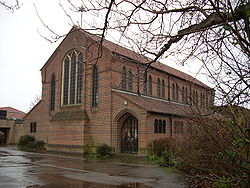Arbury: Difference between revisions
No edit summary |
|||
| Line 14: | Line 14: | ||
|constituency=Cambridge | |constituency=Cambridge | ||
}} | }} | ||
'''Arbury''' is a village which has become an integrated part of the northern developments of [[Cambridge | '''Arbury''' is a village in [[Cambridgeshire]] which has become an integrated part of the northern developments of [[Cambridge]]. Arbury borders and s contiguous with, [[King's Hedges]] and West [[Chesterton, Cambridge|Chesterton]], bordering too on the parts of the city by the [[River Cam|river]]. The village of [[Histon]] abuts it too. | ||
==History== | ==History== | ||
Latest revision as of 11:32, 10 December 2015
| Arbury | |
| Cambridgeshire | |
|---|---|
 Church of the Good Shepherd | |
| Location | |
| Grid reference: | TL457611 |
| Location: | 52°13’44"N, -0°7’59"E |
| Data | |
| Post town: | Cambridge |
| Postcode: | CB4 |
| Dialling code: | 01223 |
| Local Government | |
| Council: | Cambridge |
| Parliamentary constituency: |
Cambridge |
Arbury is a village in Cambridgeshire which has become an integrated part of the northern developments of Cambridge. Arbury borders and s contiguous with, King's Hedges and West Chesterton, bordering too on the parts of the city by the river. The village of Histon abuts it too.
History
The area has been occupied since at least Roman times. In the 1950s, stone coffins from the 2nd century were discovered, as well as the remains of a Roman villa and mausoleum.[1] In thew Middle Ages a decaying circular earthwork of unknown age was visible just to the north of where Arbury Road meets Histon Road (now part of Orchard Park) and was known as Hardburgh Camp by the 13th century. This later corrupted to Arborough and then Arbury. The earthwork was formerly around 100 yards long, though its western half (extending into Impington) was no longer visible by the start of the 19th century.[2] It is thought to have been an undefended Iron Age enclosure to protect animals from predators.[3]
In the Middle Ages the area was common land, and local peasants were permitted to graze their sheep on the meadow between Lammas and Lady Day. In the 17th and 18th centuries the meadows were dug for earth to make bricks.[2]
Arbury was historically part of the parish of Chesterton, the area was developed by Cambridge City Council from 1957 as a housing estate of around 100 acres.[2]
Local life
The community is served by the Church of the Good Shepherd,[4] a red brick church designed by Stephen Dykes Bower. The chancel was built in 1958 and the nave in 1963-4. Opened in 1963, it became the parish church of its own parish in 1969. The Arbury community centre opened in 1974, which is also home to the Arbury Community Church.[2][5]
The Roman Catholic community of Arbury worship at St Laurence's church in Milton Road.
Arbury Court houses a post office, library, supermarket and other local shops. The Carlton Arms public house lies on Carlton Way,[6] which follows the route of the Roman Akeman Street. Not all areas of Cambridge are as prosperous as many believe and Arbury is an example of a lower income neighbourhood. Crime rates however are lower here than in many parts of central Cambridge.[7]
References
- ↑ "Arbury's Roman past revisited". University of Cambridge. 2007-04-28. http://www.admin.cam.ac.uk/news/press/dpp/2007062802. Retrieved 2010-09-15.
- ↑ 2.0 2.1 2.2 2.3 A History of the County of Cambridge and the Isle of Ely: Volume 9: Chesterton, Northstowe, and Papworth Hundreds- Victoria County History
- ↑ Sallie Purkis (1981). Arbury is where we live. EARO.
- ↑ Church of the Good Shepherd
- ↑ Arbury Community Church
- ↑ "Pub Review: Carlton Arms". ALE (CAMRA Cambridge branch) (313). Spring 2004. http://www.cambridge-camra.org.uk/ale/313/carlton-arms.html. Retrieved 28 August 2013.
- ↑ Police.uk crime map